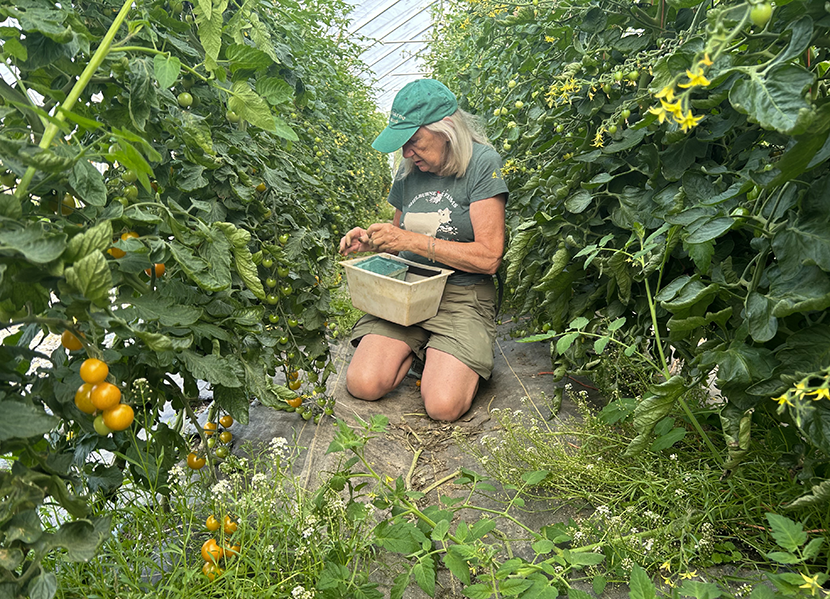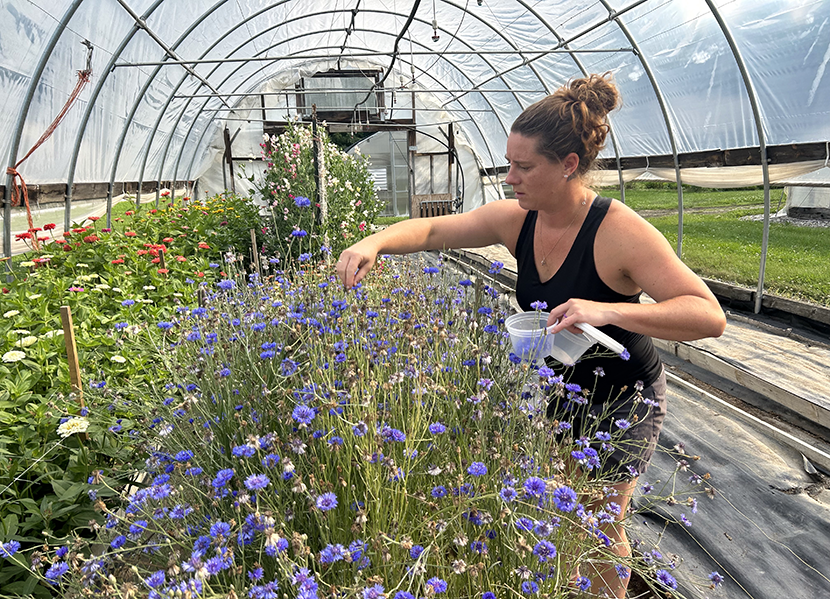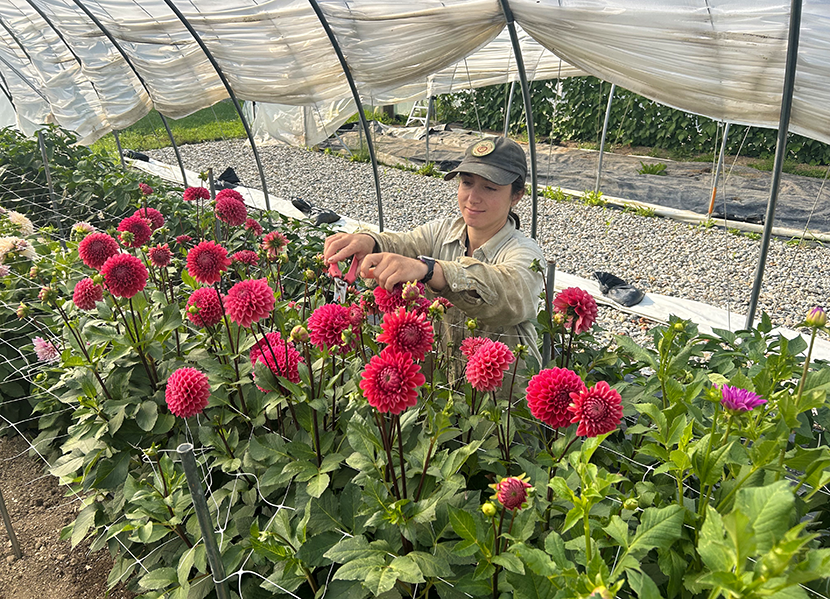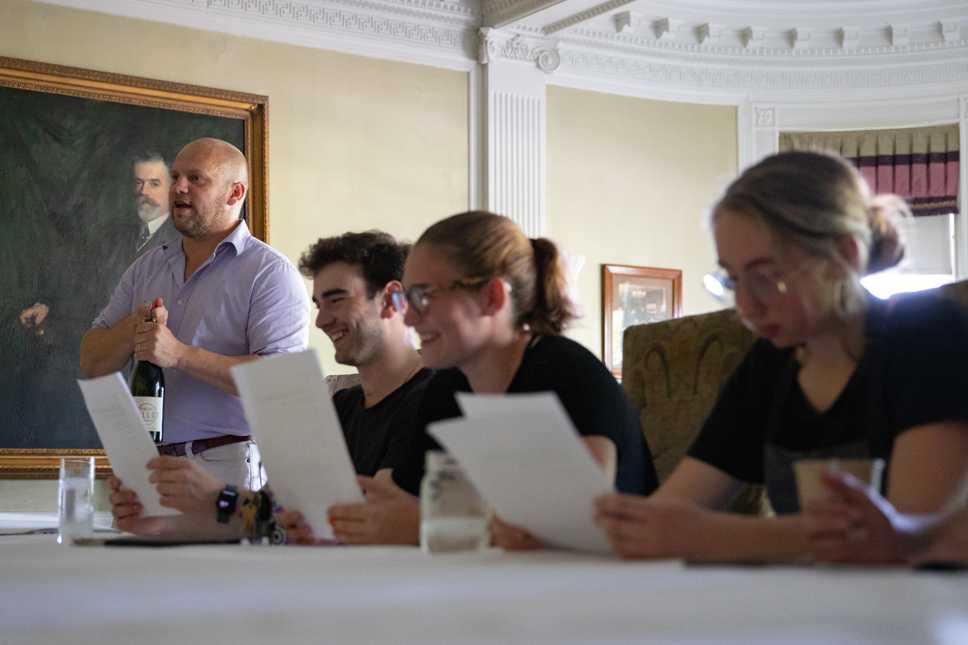This was such a pleasure to receive and browse through. I will spend more time with the videos tomorrow and cannot wait. Thank you!
24 Hours with Shelburne Farms
What does a typical day with Shelburne Farms look like? On Wednesday, July 12, we fanned out across the organization and campus to show you—to capture some behind-the-scenes moments that reflect the depth and breadth of the nonprofit’s work. You’re invited to take a peek and follow us! You’re also invited to tell us what we missed, or what else you’d like to see, in the comments. So much happens here. It’s impossible to catch it all in one swoop!
Note: A typical day for us was not a normal one for many across Vermont who experienced catastrophic flooding just two days earlier. While Shelburne Farms was spared, the flood and its impacts were on many people’s minds on Wednesday.
— MORNING —
4:29 am, Dairy Barn: Dairy herd manager Sam Dixon makes the short walk from home to the barn, prepares the milking parlor, then wakes the herd up with a whistle. “They’re unusually slow this morning,” says Sam. How did he perfect his wake-up call? “Years of practice.” The herd spent the previous day inside to give pastures a chance to recover after heavy rain. The storm, which left many Vermont farms underwater, brought just 2.5 inches of rain over two days to Shelburne. Says Sam, “We’re lucky. Very, very lucky.”
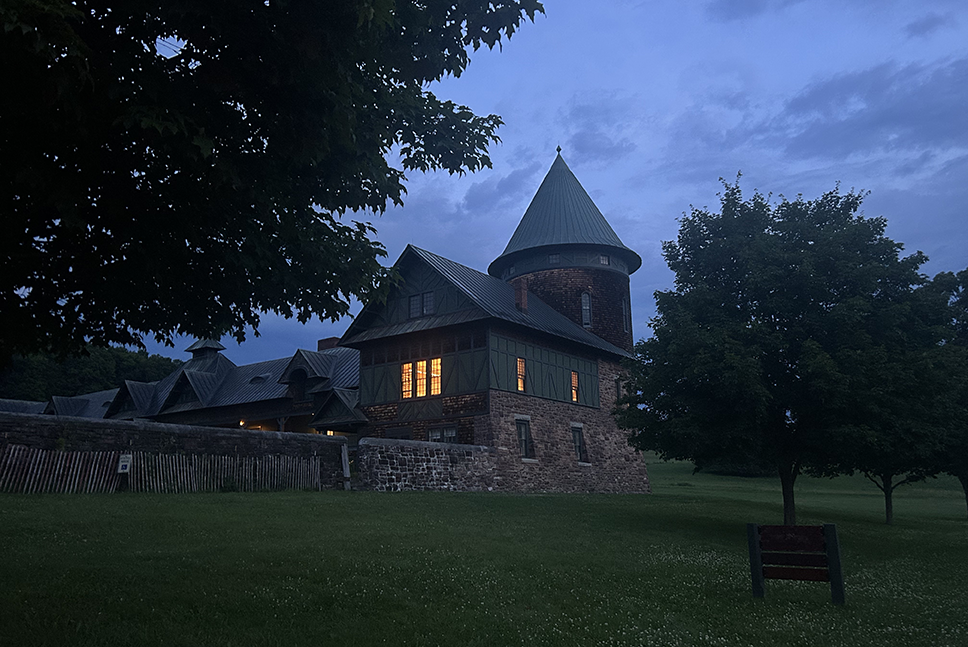
4:54 am, Farm Barn: A dairy farmer at heart, Shelburne Farms president Alec Webb starts his day early and enjoys the quiet time in the barn office before other staff arrive. He sends a lot of emails before 8 am, when he usually heads home for breakfast.
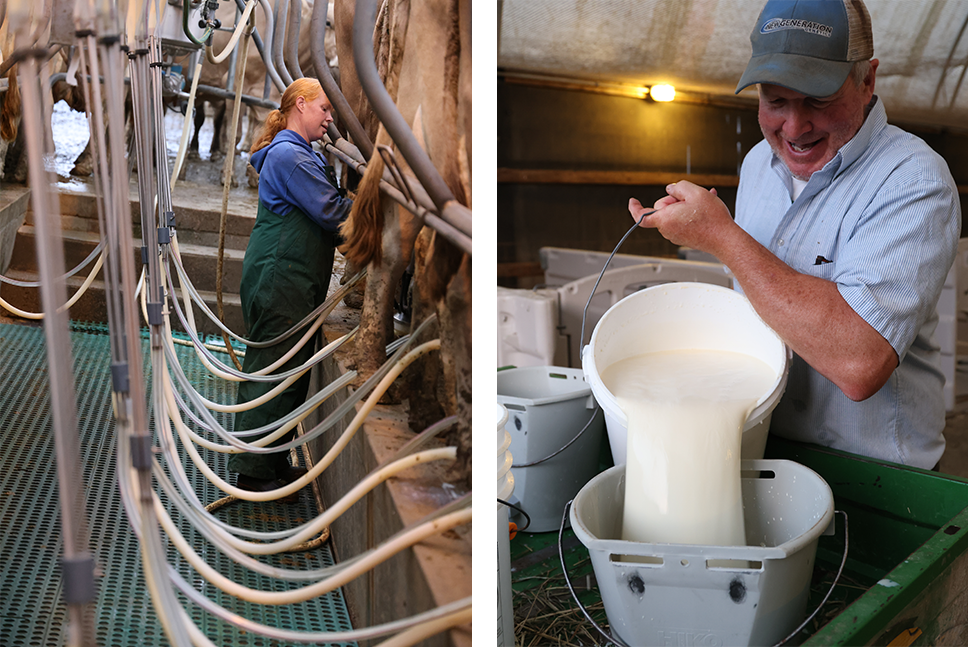
5:21 am, Milking Parlor and Calf Barn: Herdsman Renee LaCoss moves all 123 milking cows through the parlor in shifts to a soundtrack of country radio. Do the cows have a favorite radio station? “Honestly, I think it’s whatever makes the milker happy. They can tell if you’re happy,” says Renee. Some of the milk is taken to the calf barn (right), where Sam feeds it to the newest arrivals; the rest of the milk will be transformed into Shelburne Farms cheddar.
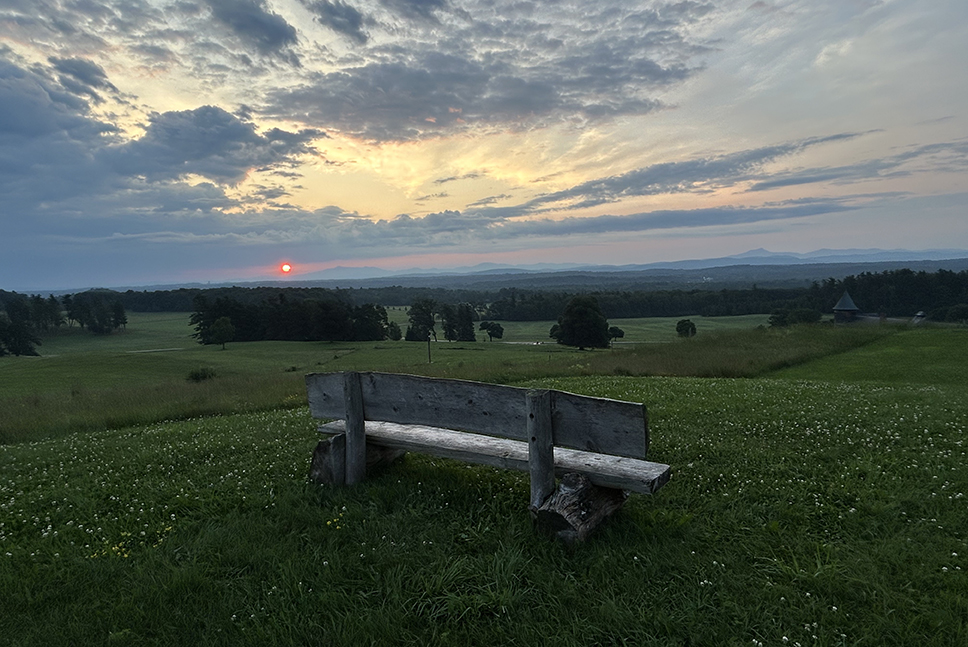
5:31 am, Sheep's Knoll: The sun rises over the Green Mountains.
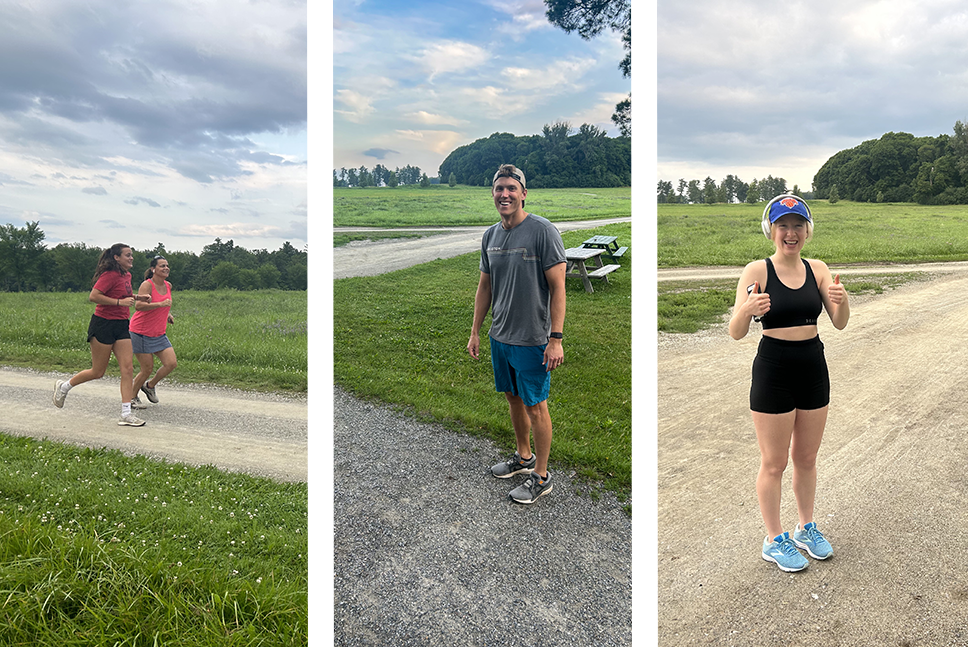
6:07 am: Early runners on the trails. Mother and daughter team Andrea and Kate Boehmcke are getting back into running and finding their groove at the farm. Charlie moved to Shelburne a year ago with his wife, who grew up running at Shelburne Farms. He’s following suit! UVM student Chloe Alexander runs here, too, and brings everyone she knows to Shelburne Farms. “Every single person!” she enthuses.
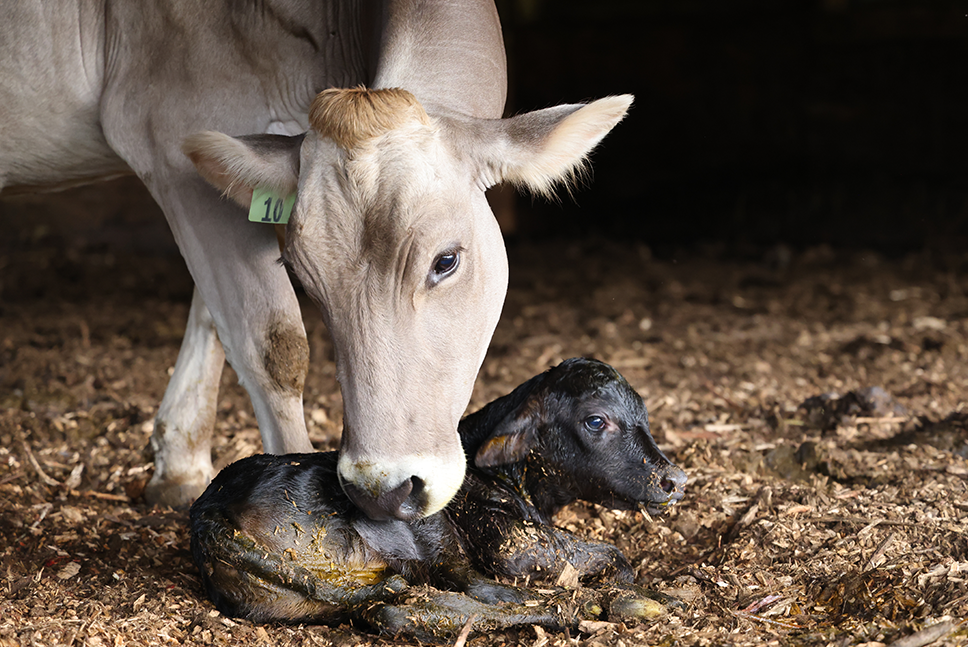
6:35 am, Dairy Barn: During morning chores, Sam’s trained eye notices one cow isn’t coming up to the trough to feed: “She must be in labor.” Sure enough, within minutes, a Swangus calf (an Angus/Brown Swiss cross) is born. “They’re a pretty vigorous breed,” explains Sam; once mom completes a thorough cleaning, the calf is up and walking.
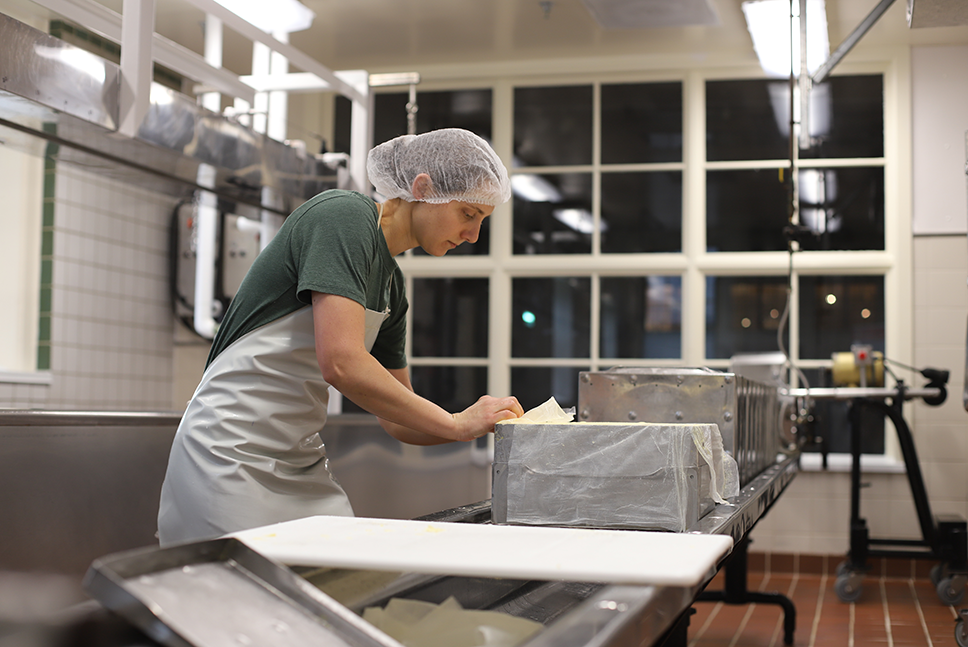
6:53 am, Farm Barn: As cheesemaker Morgan Rainville waits for the day’s milk to arrive at the cheesemaking facility, she unwraps the “hoops” of cheese from the previous day’s make. These 13 blocks—551.5 pounds of cheese—have been sitting in the hydraulic press overnight to reach just the right moisture level and will now be aged. Next door, her team is already cutting and labelling cheddar blocks as the radio booms Pink Floyd's "Wish You Were Here."
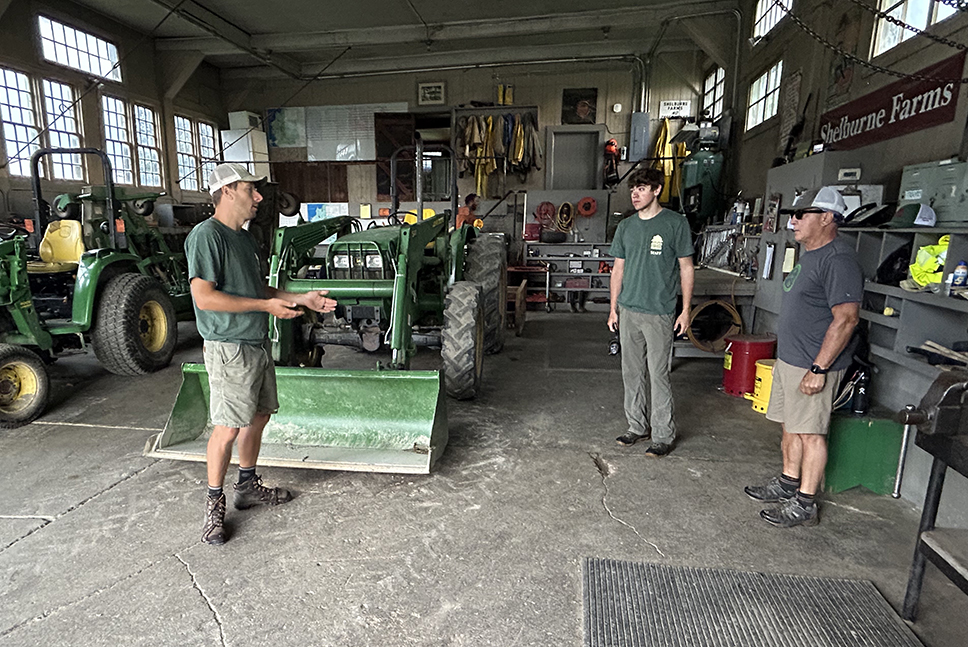
7:06 am, Tracy Barn: The Buildings and Grounds crew meets to discuss the day's work, as they do each morning. (Pictured: Travis, Teddy, and Will). Today’s list includes more road work following the heavy rains, mowing the lawns near the Farm Barn, cleaning the Coach Barn for the Cultivating Joy and Wonder educator workshop, and setting up for the evening town concert in the Farm Barn courtyard.
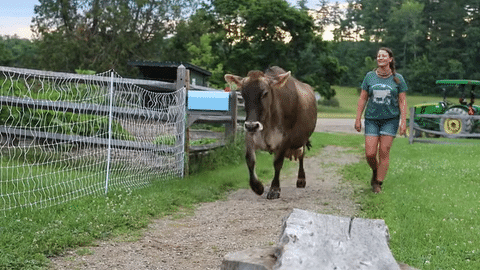
7:15 am, Children's Farmyard: Cat Parrish walks Brewer up from her evening pasture to her stall in the Children’s Farmyard. As a Farmyard veteran and creature of habit, Brewer often leads the way without halter or lead. Fresh hay and grain await her on the other end!
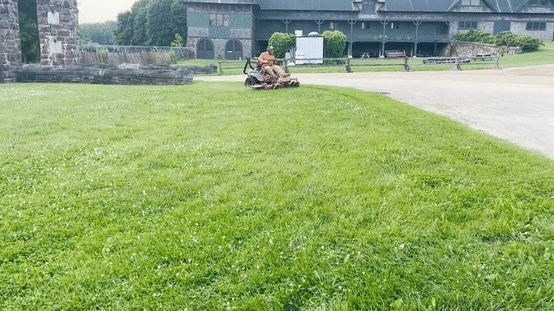
7:39 am, Farm Barn courtyard: Blake Harris mows the courtyard in one of the farm’s electric mowers, which generate zero direct carbon emissions, no harmful air pollutants, and make far less noise than a conventional gas-powered lawn mower.
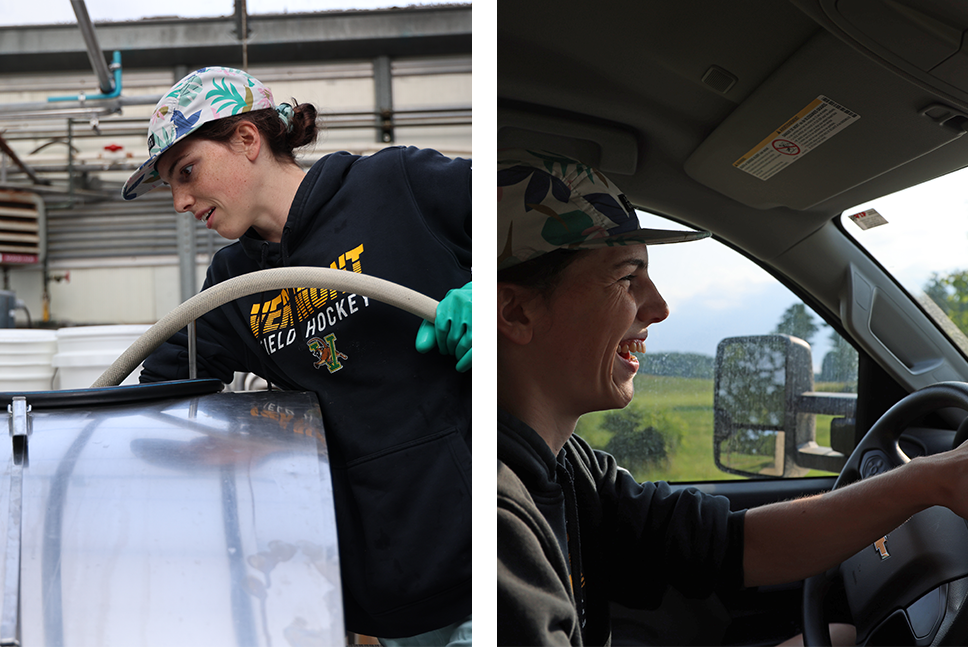
7:40 am: “This is my favorite part of the job, the hauling,” says cheesemaker Perry Willett. “You get out onto the farm and get that connection to the dairy.” Here, Perry pumps 5,376 pounds of milk (“a pretty normal haul”) from the dairy’s vat into a sanitized tank, then drives the milk a few minutes away to awaiting cheesemakers. Perry started working at the farm this spring, but her connections to the place run deep. “I was a camper here from ages three to seventeen, so Shelburne Farms is kind of embedded in my DNA.”
8:05 am, Market Garden: Linda Wellings begins picking today’s harvest: tomatoes, lettuce mix, summer squash, currants, blackberries, gooseberries, and raspberries. Every Monday, Wednesday, and Friday, the garden team sends a “pick sheet” to the Inn and Farm Store listing all the crops that are ready, and those teams select what they want picked and delivered that afternoon. Some produce is harvested daily, like cucumbers, zucchini, and green beans–Linda’s favorite. “Picking beans is my jam," she says. Flowers are on the “menu,” too, like edible bachelor buttons and beautiful dahlias, which require regular pruning by garden staff Rachel Kessler. Wynter Davis, an extern from the Culinary Institute of America, picks Swiss chard in her weekly day in the garden. “Knowing exactly where the food you’re using in the kitchen is coming from is pretty incredible,” she says.
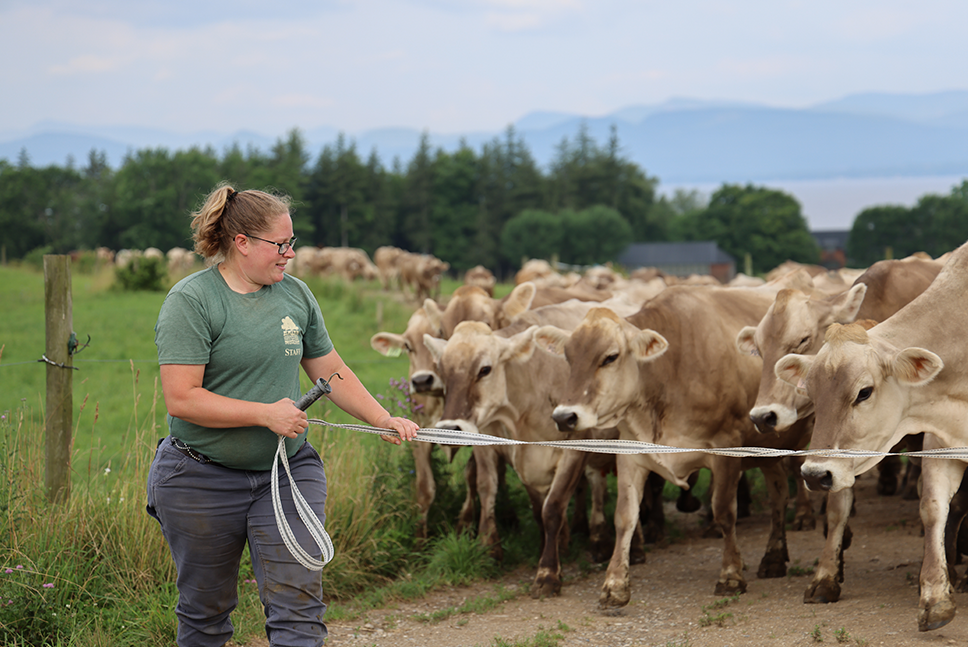
8:19 am: Morning milking is done, and the pastures are deemed dry enough for the cows to re-enter. Herdsman Megan Letourneau guides the group to the fields where they’ll spend the day. “I grew up on a dairy farm,” says Megan. “My first friends were probably calves.”
8:28 am, Farm Barn: With hot temperatures coming, Buildings and Grounds manager Wally Allen and curator of collections Julie Eldridge Edwards get a jump on weekly clock-winding, climbing the 89 steps to the tower to wind both the bells and the clock mechanism and adjust the exact time as needed. Later Julie will do the same for the Coach Barn clock. Winding the bell requires 36 crank rotations. Does it get harder as you go? “It certainly feels like it!” Wally huffs as he finishes up.
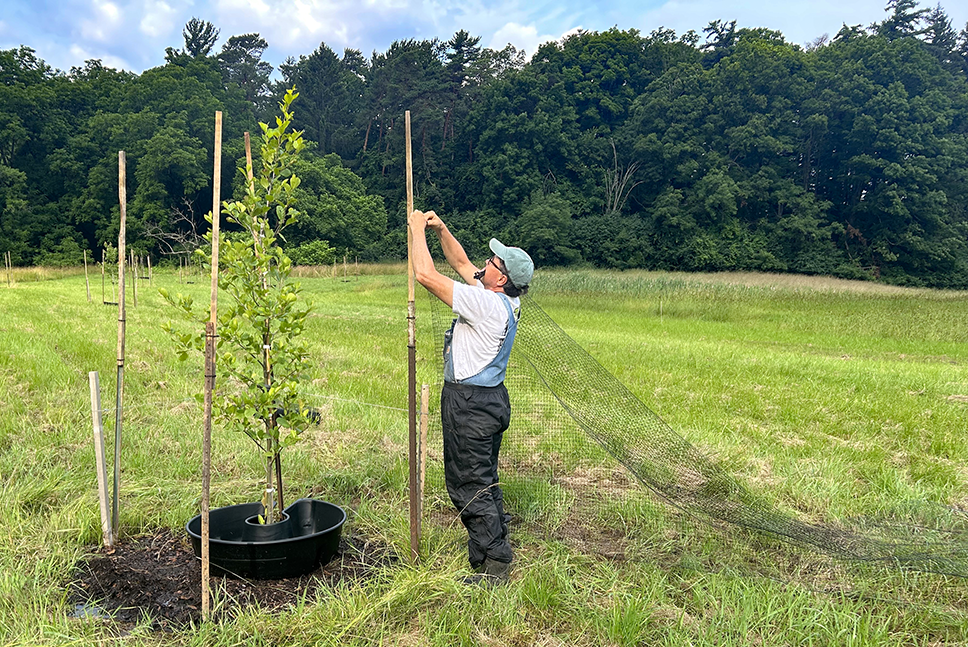
8:52 am, Dairy pastures: Woodlands crew member Jacques Marton places deer netting around the 59 new saplings that we planted this spring as part of our climate action silvopasture strategy. The young trees need protection now, but as they grow tall in the pasture, they will sequester carbon while offering shade to cows or sheep.

8:57 am, Educator Collaboration Center: Our director of professional learning Jen Cirillo does a last minute check-in with her co-presenters before the 9 am start to Foundations in Education for Sustainability, which is offered to teachers for graduate credit in partnership with the University of Vermont. Jen leads this online component from a temporary unit behind the Farm Barn that’s dedicated to virtual meetings. It makes facilitating discussions with educators from around the world a lot easier!
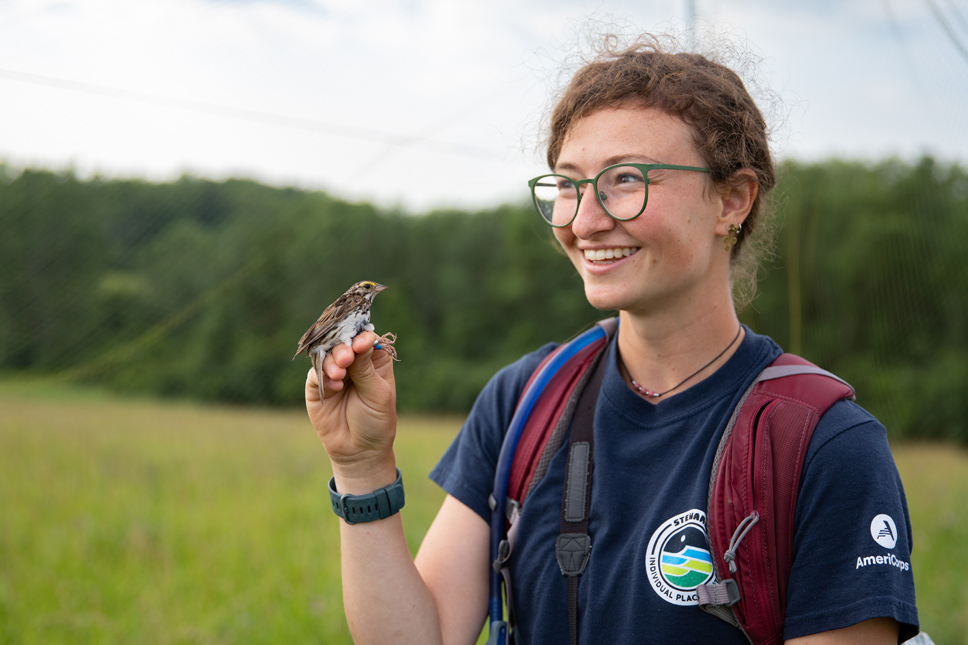
9:43 am, Windmill Hill: Undergraduate and graduate students from the University of New England monitor grassland birds on campus. “Noah Perlut [their professor] has been conducting this research at Shelburne Farms for over twenty years,” shares Katie McGee, a graduate student and researcher. “He has a huge database of bird and migration data, and students add to it every year. This is a unique opportunity as a graduate student—we have so much data that we can analyze to test different hypotheses relating to pasture practices, bird health, weather, and migration patterns.”
10:03 am, Welcome Center: The first tractor shuttle of the day leaves from the Welcome Center and heads toward the Farm Barn, with driver Rick Bessette at the wheel welcoming visitors.
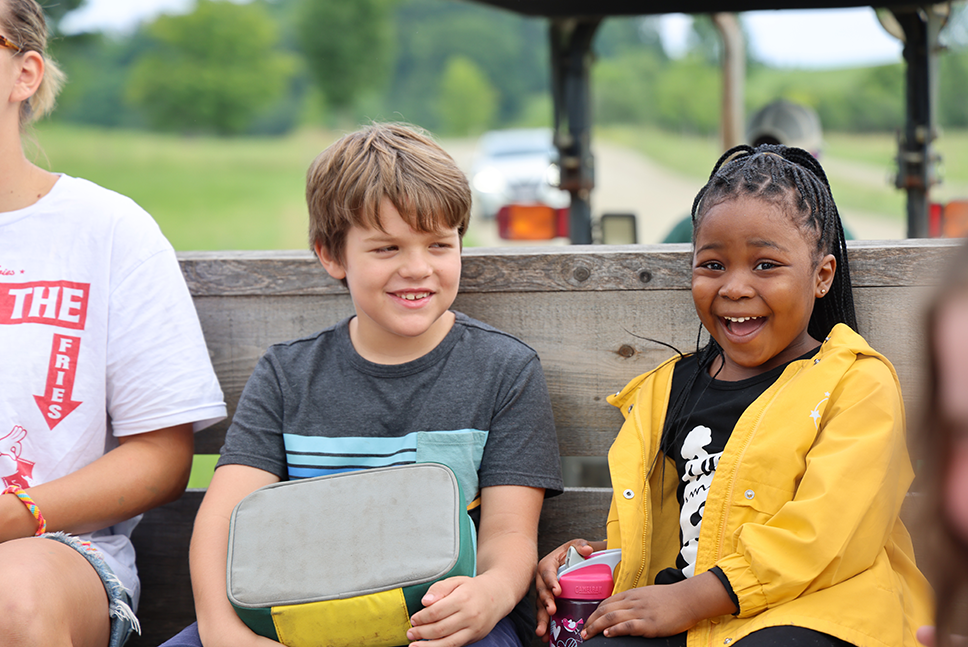
10:04 am, North Gate Road: Summer campers cover a lot of ground at the farm. Here, our younger group takes a tractor ride from the Farm Barn to the Dairy, spotting grazing cows and singing songs along the way.
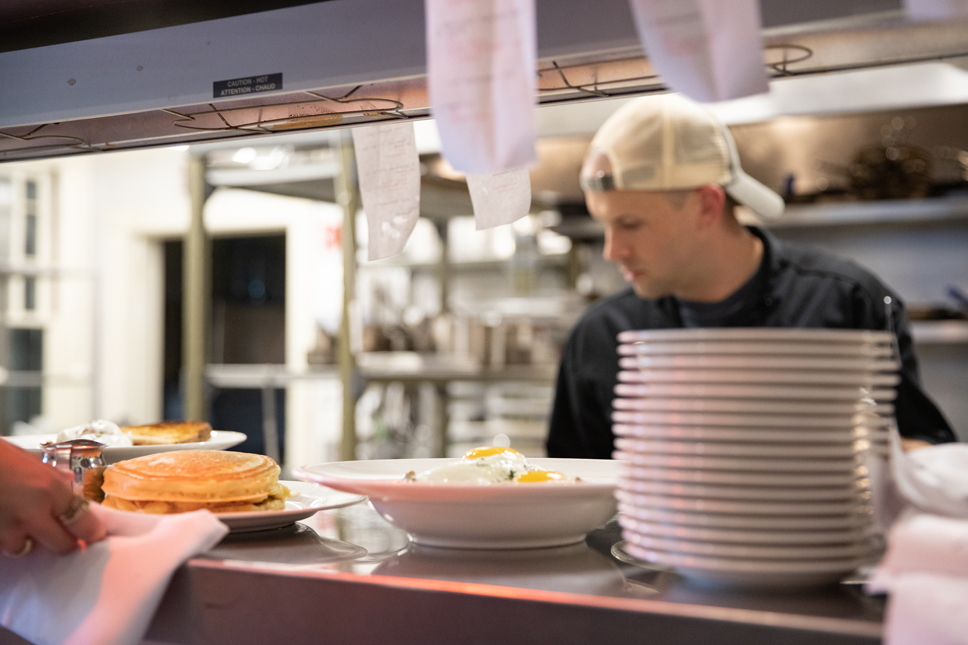
10:20 am, Kitchen: Breakfast is in full swing at the restaurant. Kitchen staff arrive before 4:30 am to prepare for the day’s service. About 90–100 diners usually come through the dining room on a weekday morning, with more on the weekends. On this morning, "We’re having some supply issues due to the flooding across the state," shares Chef John Patterson. "We usually have Wednesday produce deliveries, but not everyone was able to get here."
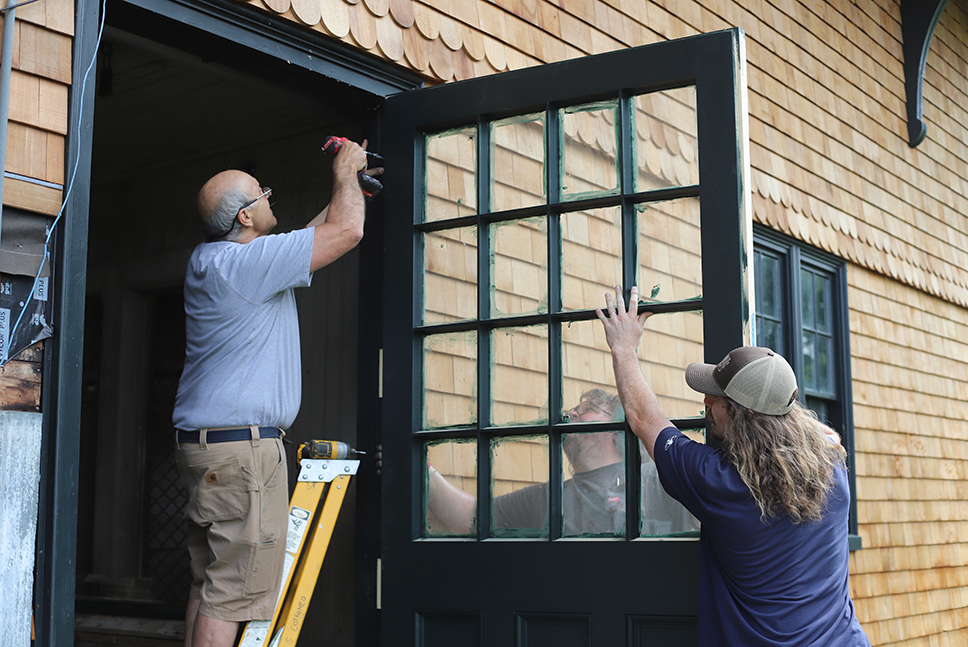
10:29 am, Breeding Barn: With the extensive re-shingling project winding down at the Breeding Barn, Mike Cotroneo, Adam King, and Joe Cotter of Porter and Associates move in to re-install exterior doors on the building, both restored originals and reproductions. Adam assesses his years devoted to the barn’s “millwork”—the windows, doors, and trim: “It’s the best thing I’ve ever done,” he says. “It’s bittersweet getting to the end.” Then he smiles, “You’ll notice we’re not really rushing here.”
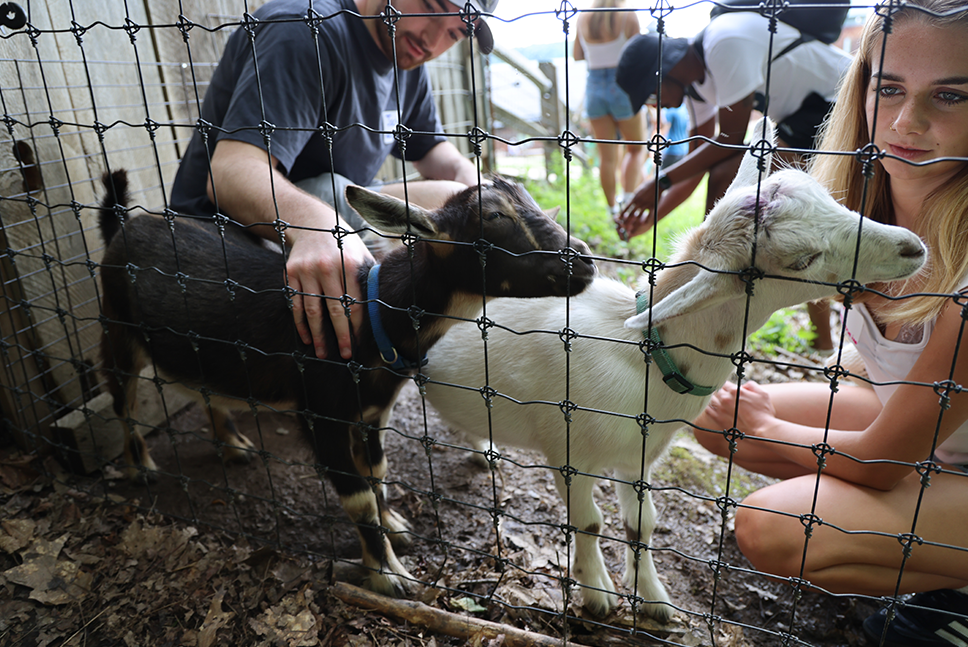
11:13 am, Children’s Farmyard: In a day-long employee orientation (one of several throughout spring and early summer), Shelburne Farms staff members Jack and Sophie meet the goat bucklings.

11:15 am, Flower Gardens: Horticulturist Paul Wieczoreck adds later season annuals to the garden surrounding the fountain and maintains all the beds. "Abundant rainfall means abundant growing,” Paul laughs. “That includes weeds, too!" In between planting and weeding, Paul talks all things gardening with visitors. "It’s great to see lots of people back in the garden,” he shares. “People are always asking me questions, and I love the opportunity to engage people about the landscape. Gardens are a great way of starting a conversation about taking care of place."
11:33 am, CSWD Materials Recovery Facility. Early childhood educators in our week-long workshop Cultivating Joy and Wonder leave the farm to learn about the recycling process with a hands-on tour of this Williston facility. “An important part of this program is getting out into the community and meeting community partners,” explains professional learning facilitator Jed Norris. “Here we’re talking about what’s behind the ‘blue bin’ and what it takes to make recycling happen. It takes a whole system to create the conditions for sustainability.”
— AFTERNOON —
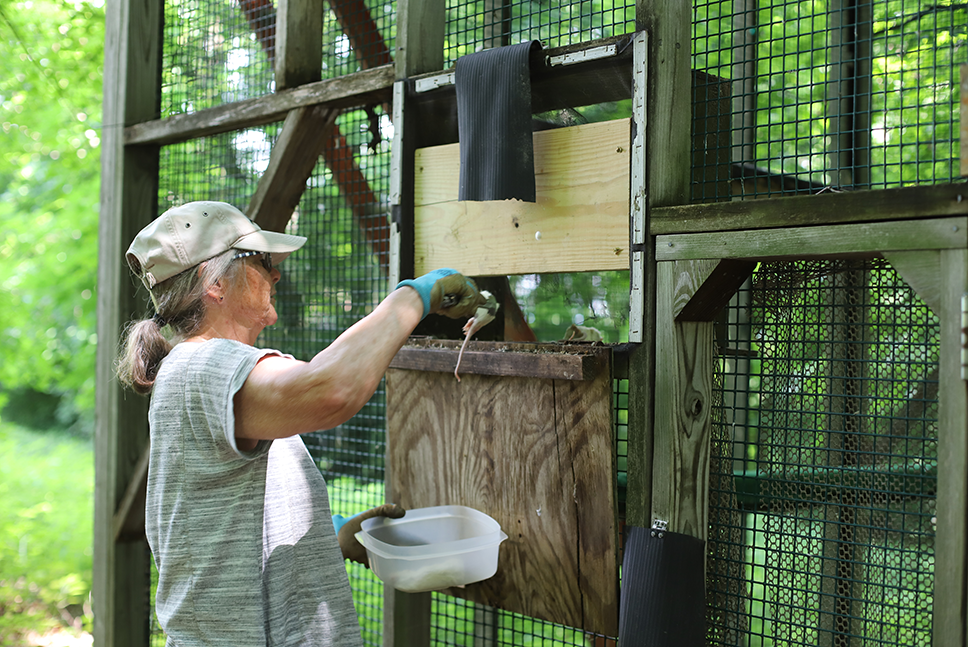
12:17 pm, OFES aviaries: It’s lunchtime for the hawks at Outreach for Earth Stewardship’s aviaries on the farm, and volunteer Judy Wolf distributes a carefully weighed diet of thawed dead mice. OFES has 12 permanent education raptors (you can meet some at Raptors in Residence), and about an equal number being actively rehabilitated for release. “Yesterday the phone was ringing nonstop,” director Craig Newman reports. “So many birds were disrupted by the storm, especially birds nesting along marshy areas now under water.”
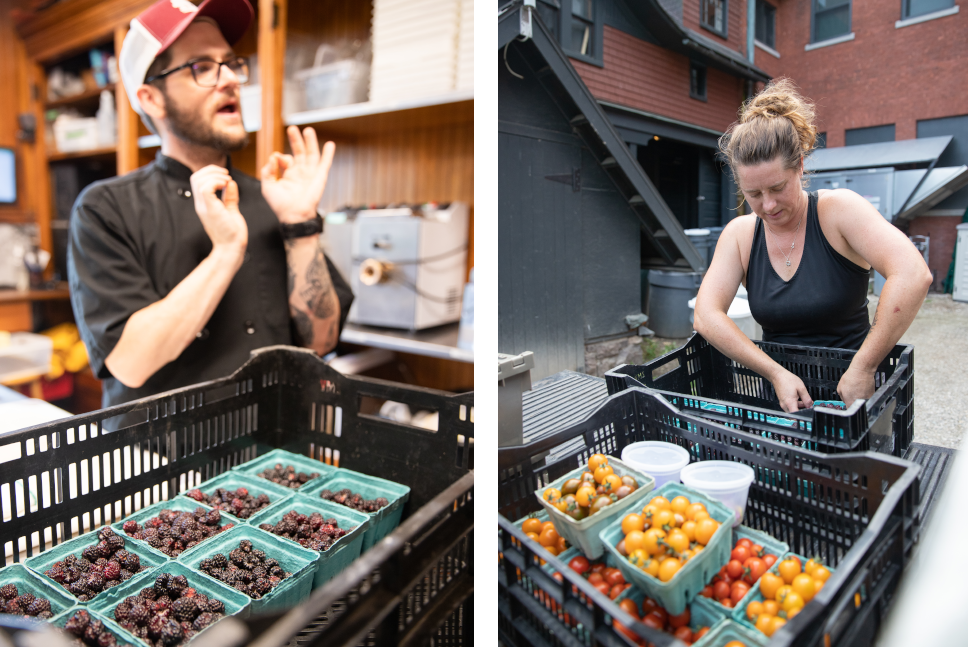
12:40 pm, Inn: Market Gardener Jamie Hayes delivers the day’s harvest to the restaurant. “It’s great to get to know the kitchen team and talk with them about the food we grow,” Jamie says. “I get to share with them about the growing side, and I get to learn about all the incredible dishes they make in the restaurant.” Upon delivery, Jamie and Chef Matthew talk blackberries (don’t harvest in the rain, they’re too mushy). Later in the day, the Market Garden team delivers fresh produce to the Farm Store, too.
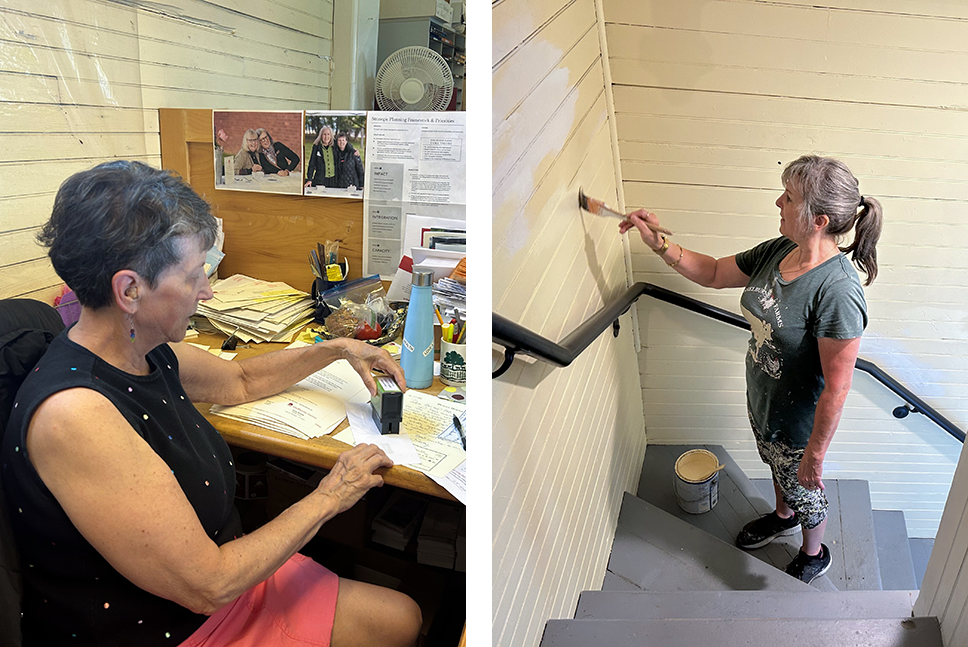
12:52 pm, Farm Barn offices: Gift administrative coordinator Jane Boisvert prepares the biweekly donation deposit. Jane grew up on the farm, where her father John worked for 54 years. Meanwhile, Aline LeClaire paints the reception stairwell. Her farm connections run deep, too. "Painting is in my blood," she says. "And my father painted here over seventy years ago," she says. "He even painted his name inside the Farm Barn clock tower: L. Rouchleau."

1:15 pm, Kitchen: The lower kitchen space in the Inn is devoted to preparing onsite food for the Farm Cart, events, and Inn pastries. Today was extra busy, as the team was cooking for the evening concert; Farm Cart; a week-long professional learning program for educators, Cultivating Joy and Wonder; a new staff orientation; and restaurant desserts and breakfast pastries. Here, Chef Veronica pulls out freshly made hoagie rolls for the sausage sandwiches to be served during the evening concert.

1:59 pm, Gatehouse: Changing of the guard. Jay Moore (left) takes the afternoon/evening shift as gate greeter, relieving Chuck Conn (right). Both are long-time staff. “I love greeting people here at the gate." says Chuck. "It’s so much fun. I love everything about it." Jay nods, "It's been good."

2:00 pm, Farm Store and Welcome Center: Sara Smith organizes all the produce just delivered from the Market Garden (their second stop of the day). Outside, longtime Shelburne Farms volunteer Dave Crane kicks off a Sun to Cheese Tour, which traces the story of how we make cheddar at the farm. "One young woman on the tour from California said it was one of the best afternoons of her life, here at the farm," Dave recounts. "I always just end with, 'Come back and see us again!'"
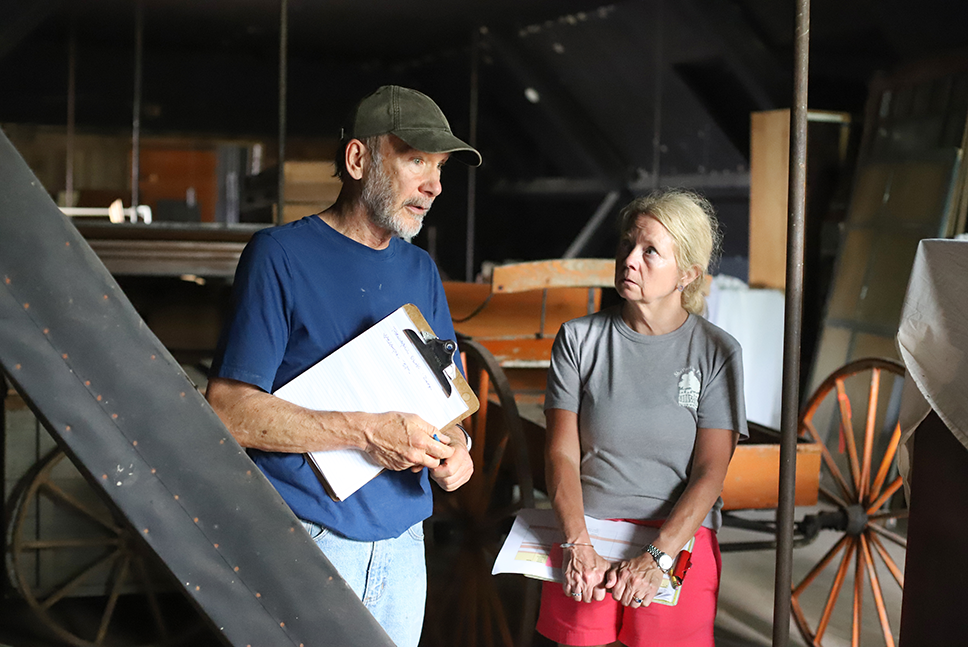
3:15 pm, Coach Barn: Curator of collections Julie Eldridge Edwards meets with Steve Smith, architect for Shelburne Farms, to evaluate the building furnishings. The Coach Barn will undergo extensive renovations over the next year or more. “It’s good for him to know what exists,” explains Julie, “so that as he’s planning and designing new spaces, he knows what he has to work with or what might be repurposed.”

4:19 pm, Farm Barn courtyard: A young camper lends a hand to Children’s Farmyard staff as they walk our education flock to pasture for the night, a daily ritual.
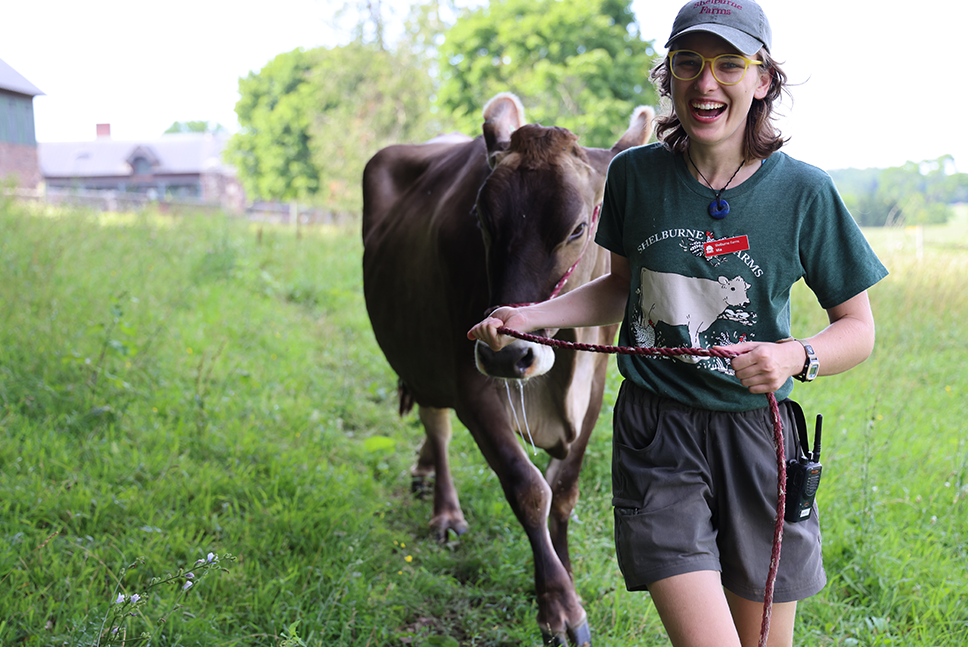
4:35 pm, Farm Barn: A few minutes later, Mia leads Brewer back to her pasture. Another day’s work done.
4:35 pm, Restaurant: Dining room manager and beverage director Scott Doherty leads a pre-service meeting with the front of house restaurant staff. They discuss new wines added to the list, how they could be paired with the evening’s menu items, and Scott shares the stories of the producers behind the bottle. Chef Matthew joins to inform everyone about menu changes and a special: locally wildcrafted golden Chanterelles with Japanese eggplant from the Market Garden. The vegetables are skewered, grilled, and served with apricot green tomato chutney (the green tomatoes are from last year’s growing season and pickled over the winter and spring).
— EVENING —
6:24 pm, Dairy: With afternoon milking complete, the herd settles in for the night with farm-fresh roughage from our pastures.
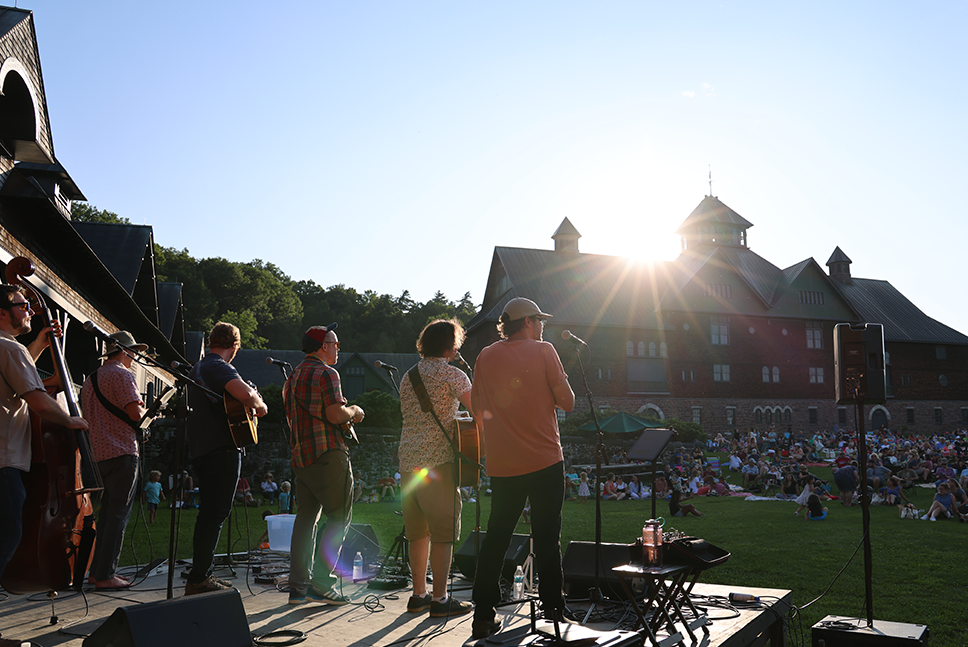
6:46 pm, Farm Barn courtyard: Local string band "The Tenderbellies" take the stage for a free Town of Shelburne concert.
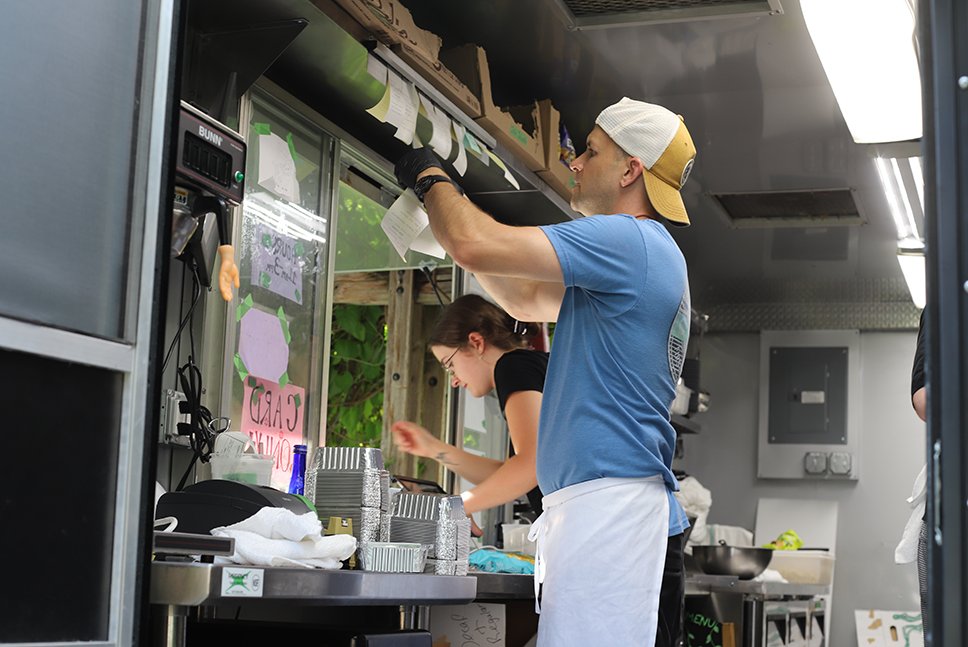
6:46 pm, Farm Cart: Chef John and staff serve up farm burgers, sausages, and grain salads to the concert crowd. They'll sell out on everything before the music ends.

8:25 pm: As diners and guests enjoy the beautiful evening at the Inn, the sun sets.
All photos & videos by: Holly Brough, Andrea Estey, Robin Turnau, and Sarah Webb. CSWD video by Jed Norris. Office photos by Anna Dundas. With thanks to everyone on staff who welcomed us into their day.
Comments
I loved this so much. Thank you for sharing
Wonderful work. Try it again in the fall if you all have the energy. Exceptional effort .
Fabulous! Loved sharing with our friends here at home in Pennsylvania. Now they get to see where we spend time each year and why Shelburne Farm is such a unique
destination.
Thank you for giving all of us an opportunity to experience a day at Shelburne Farms. The tremendous amount of work and effort by all who run and maintain the farm results in so much goodness, calm and beauty for all of us to enjoy.
Our trips to Shelburne from here in California are infrequent, so it was great to have this vicarious visit! Fun to see all the characters at work on the Farm, people and animals alike. And it was good to learn that you were not overwhelmed by tragic deluges that hit elsewhere in Vermont.
Fantastic! Shelburne Farms is such a beautiful place! Thank you for sharing and I can’t wait to visit again!
